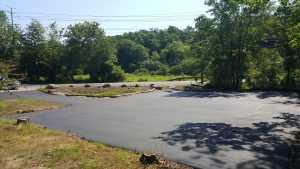Stormwater is one of the largest polluters of surface water in our area. When rain falls to the ground and lands on impervious surfaces (such as roads, rooves, driveways, and more), the water collects all of the pollutants on this impervious cover and dumps them in concentrated amounts wherever the stormwater drains to. Often, the stormwater drains into streams or ponds and the wildlife in these areas can be negatively impacted. Luckily, there are ways to reduce the amount of pollutants that are able to enter surface waters. Some strategies focus on not allowing stormwater to collect pollutants in the first place. These strategies include cleaning up pet waste, properly applying fertilizers and pesticides, and proper septic system maintenance. Other strategies focus on cleaning the polluted stormwater before it can reach surface waters. One strategy in this category is creating rain gardens.
This fall I’m going to be a senior at UConn. I’ve been studying Natural Resources with a focus in Water & Climate for the last 3 years. I first heard about rain gardens in a Water Resources class that I took during the fall of 2014. Dr. Michael Dietz taught the class and put a large emphasis on the importance of Low Impact Development in order to protect water quality. A major LID strategy he taught us about was the creation of rain gardens. When I first learned about them, I was a little confused as to how a strategically created garden could possibly be a solution to a pollution issue that I didn’t even know existed. Throughout the course, the topic of rain gardens came up from time to time, and as a class we even saw examples of rain gardens and other LID techniques used around the UConn Storrs Campus. I was amazed at how such a simple creation could have such benefits for local water quality and I didn’t understand why rain gardens weren’t used everywhere. I figured there must be some catch; either they were too difficult to create or they were too expensive, or something along those lines.
In early spring, I was offered a position as an intern working with CLEAR’s stormwater department. I soon found out that Dr. Dietz was also a member of CLEAR and I would get to see how some of these LID strategies that he taught in the classroom could be applied to real scenarios. Working primarily under Chet Arnold, Dave Dickson, and Mike Dietz; I worked mostly with the new MS4 Stormwater Permit coming into effect, so LID strategies were a popular topic around the office, including rain gardens.
One day I had a chance to go to a site and help install a rain garden at a house in Storrs just off of the campus. This gave me the chance to see firsthand what the upsides and downsides of installing a rain garden were. The reason this site was chosen was because the runoff from the house and parking lot drained directly into Eagleville Brook. When I got to the site, an appropriate area had been excavated for the rain garden (as calculated in the Rain Garden app). It seems that excavating this area and adding underground drainage pipes would have been the most labor intensive part, but in this project heavy machinery was used. This made the project easier for us, but also more expensive and required funding from a Section 319 grant from DEEP. Since the area was already established, the next step for us was getting right into planting. Between the 5 or 6 of us transferring plants into the ground, we had dozens of switchgrass, lowbush blueberry, winterberry, cardinal flower, and butterfly milkweed planted within hours (appropriate plant lists can also be found in the rain garden app). We then spent the next hour or so mulching the rain garden, and the end result was amazing. We had this brand new rain garden finished before lunch time. That means that it only took us a few hours to create this LID measure that would clean stormwater runoff from this property and reduce pollution to Eagleville Brook with minimal maintenance.
Not only was the rain garden functional, but it looked great too. Many people enjoy creating gardens as a hobby, but don’t realize that without much extra effort they could create a garden that greatly reduces pollution caused by stormwater runoff on their property. The example I helped with was a large model, but smaller rain gardens can also be effective and require less effort and cost to create. If more people were aware of the benefits of creating a rain garden and realized that there are tools out there to make the project easy for them, I believe that many water quality issues around the state could be improved. When people start realizing that you don’t need to be a professional to make a difference, then we’ll start seeing even greater results.
Written by Will Teas, a stormwater intern at CLEAR.
